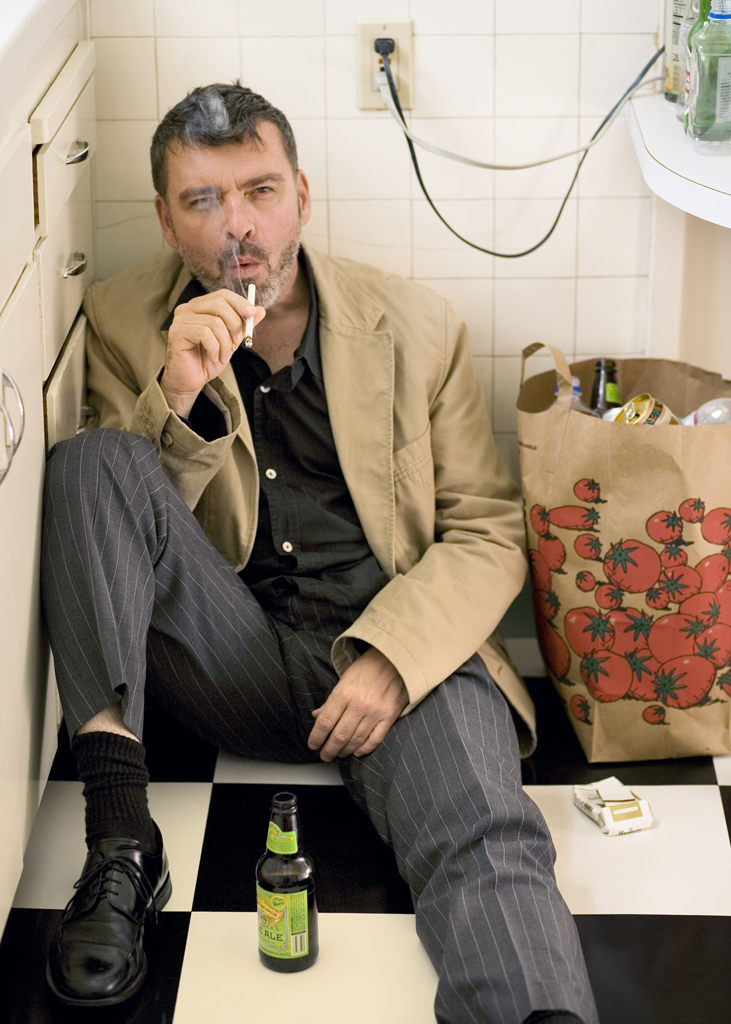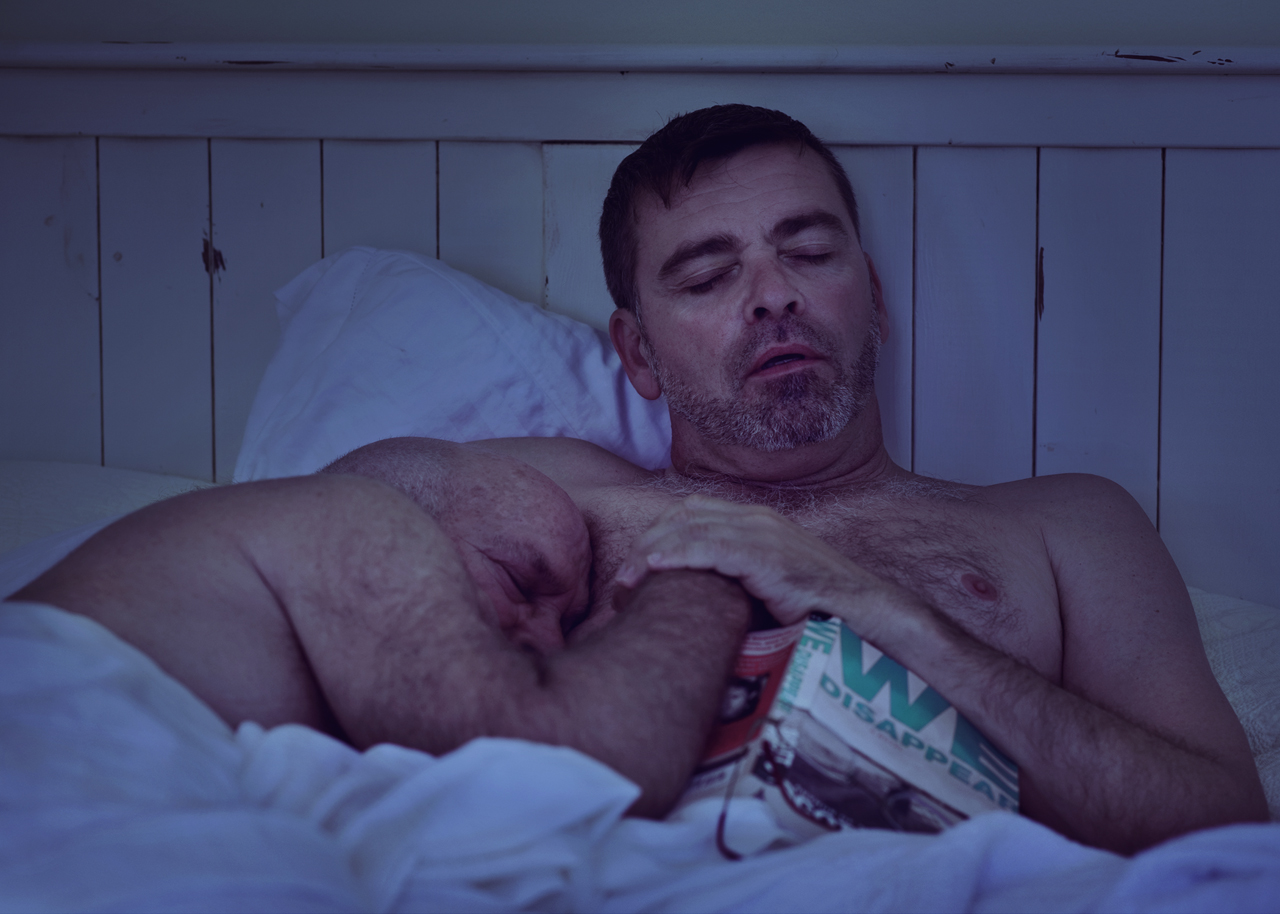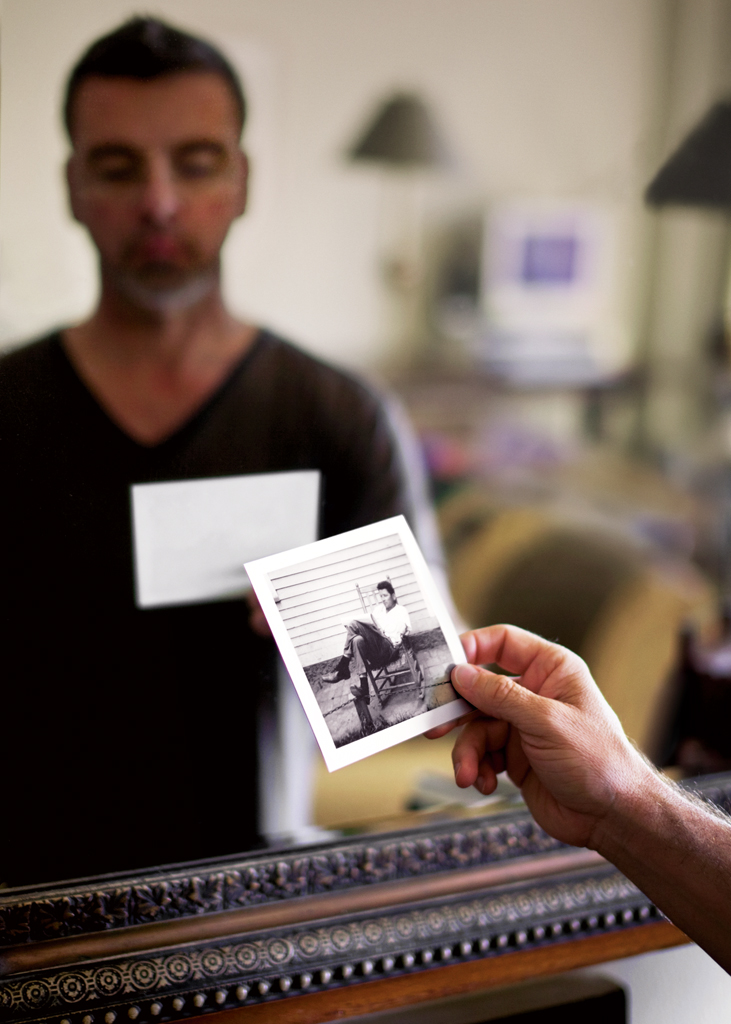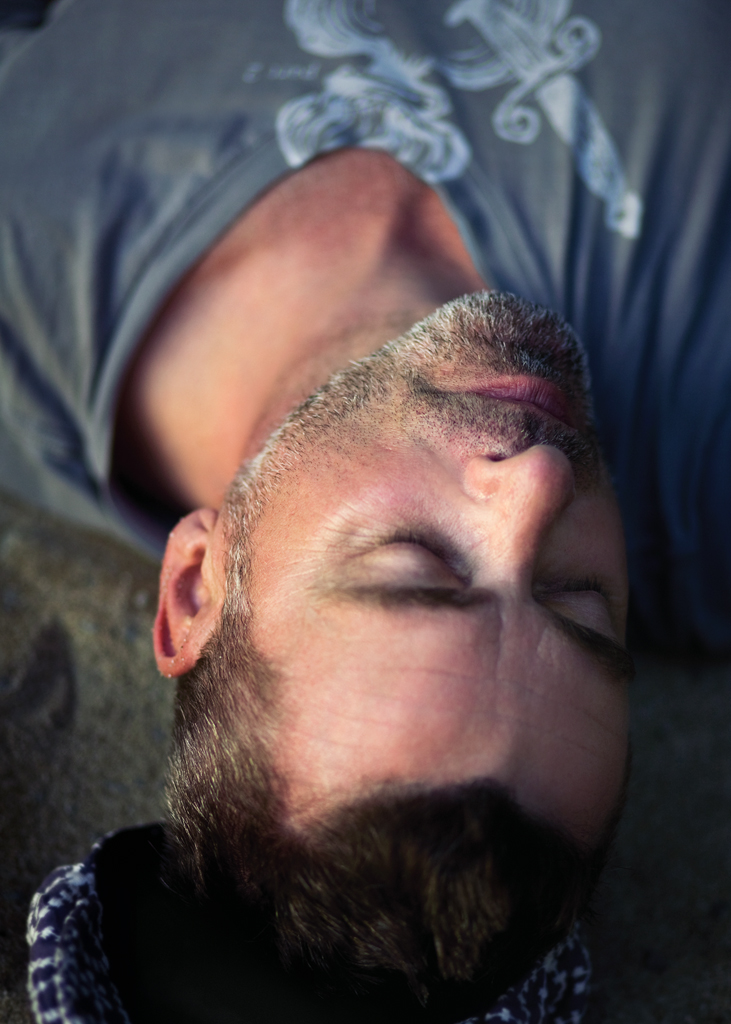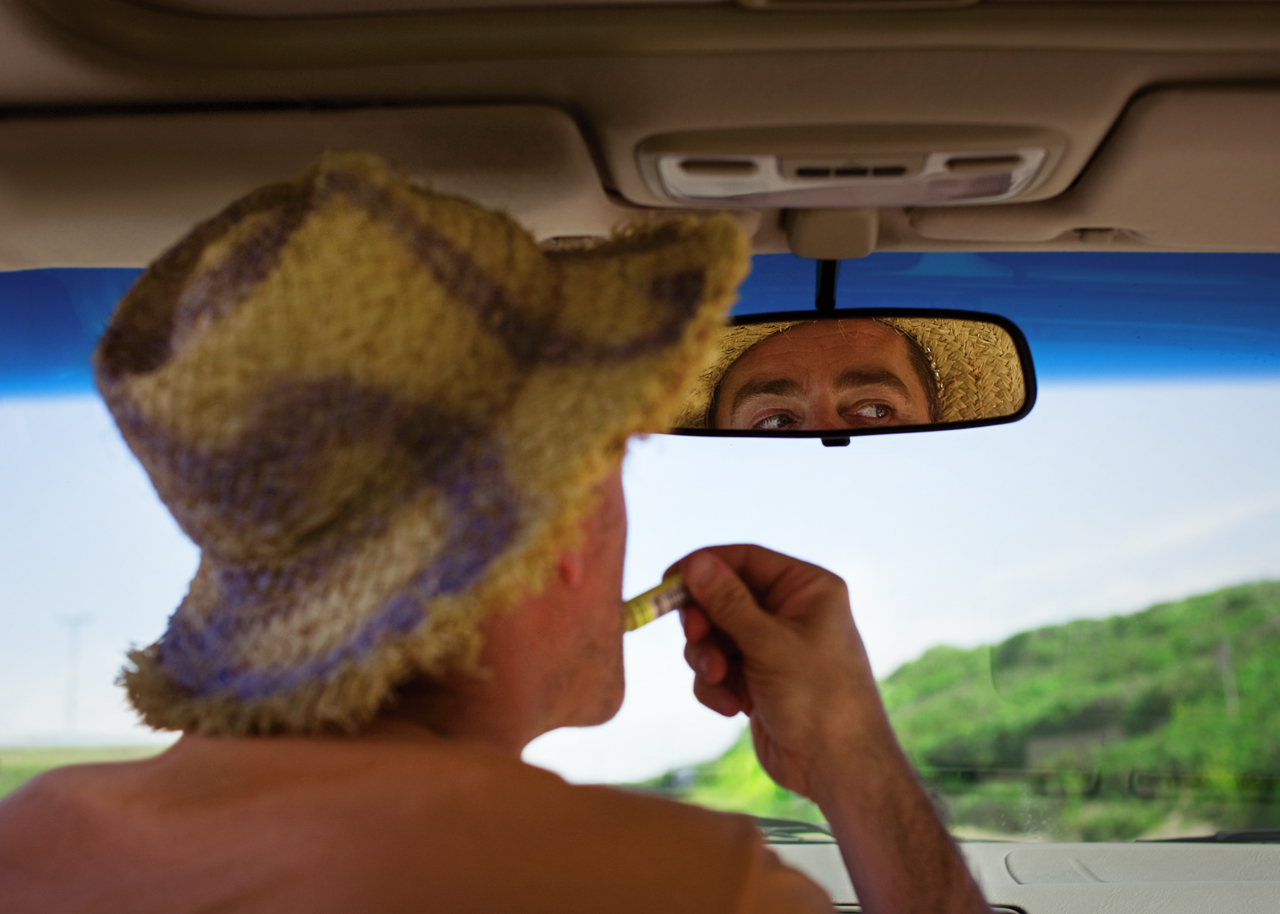at Length
Frank Yamrus
interview by Darren Ching and Debra Klomp Ching
Untitled (Single Man) © Frank Yamrus
At Length: You’ve been a producing artist for some 20 years, but it’s been 6 years since your last solo exhibition in New York. Why has it been so long?
Frank Yamrus: Yes, you are absolutely correct. My last one-person exhibition in New York, Bared & Bended, was a collection of 42 images—landscapes documenting my first and only winter in Provincetown on Cape Cod. These images were made in 2004 and at that time I was struggling with a personal relationship and starting to feel burnt out by my photography career. It seemed quite natural for me to seek refuge, in this place that I call my spiritual home, for contemplation.
Over the course of my winter on the Cape, I found great solace in this landscape, seemingly familiar but now blanketed by winter’s elements and surrounded by thick wintry light. After making this work, I put my camera down to reevaluate my career in photography. It was not until a couple years later that I felt the creative juices flowing, and again, it was a personal crisis—of sorts—and while in Provincetown, that inspired me to reach for my camera.
This six-year lapse reflects the time it took me to make this work and, to be quite honest, to feel comfortable with releasing this highly personal body of work to the public. Early in the process I showed some images to get feedback, but then went back to work very privately and quietly. I rarely shared any of these new images made after 2008. Last year, when Brian (Clamp) and I sat down to look at the work, he was surprised at the depth of the portfolio.
Untitled (Smoke) © Frank Yamrus
AL: It’s no secret that your newest body of work, I Feel Lucky, really results from—or at least was sparked by—a mid-life crisis. What role have the photographs performed, in the journey that you’ve made as you approached and passed the age of 50?
FY: As a photographer I don’t think I knew of another way to process this landmark event, so it was quite natural for me to reach for my camera and make these photographs. That very first impulse to take a picture felt unsurprisingly familiar and yet awkward, as I was not convinced I was ready to make work. However, once I made the first image, I was seduced, and the project began to slowly, but consistently, reveal itself. As I documented this journey, it gave me the opportunity to take another look at my life’s decisions and retrace my path to 50 as well as look beyond.
Initially, I made photographs about the “big” decisions, and some of those images feel appropriately iconic. As the project expanded, the “smaller” moments gave life to the narrative and helped me to see a more congruous life. Most of all, this process was empowering, as the images became cornerstones of my understanding, each image leading to another, creating dialogue to address the complexities of identity and life. Ultimately, I felt confidence and inspiration from these pictures and the response to this work has reinforced those emotions.
AL: Throughout the series, we witness the whole gamut of dispositions and emotions that you’ve experienced—humor, introspection, loss, joy, frustration, uncertainty, self-gratification, confidence—and yet, together, I Feel Lucky appears to be just a small glimpse of Frank Yamrus.
FR: Life is full and very complex. I agree this is but a glimpse of Frank Yamrus. Diane Arbus once said, “[a] photograph is a secret about a secret. The more it tells you, the less you know.” I subscribe to this sentiment and my imagery is, and has always been, about process and not about resolution.
The I Feel Lucky images, individually and collectively, inform. They are the evidence of life’s full spectrum of offerings: my hopes and dreams, my joy and sorrows, my happiness and pain, etc. And in spite of the filters of time and memory, the human desire to fabricate and stretch reality, these images feel authentic, and provide clarity and insight. Surely they capture the essence of my identity but, by no means, reveal all my secrets or truths.
Untitled (Boo Boo) © Frank Yamrus
AL: Does this survey of feelings, then, suggest a lack of answers, a lack of catharsis in facing up to and surviving a questioning of identity? Or would you say they represent an acceptance or acknowledgment of who and where you are?
FR: This survey of feelings is the very foundation of self-identity, and does not represent a lack of answers at all. As my personal history played out before the camera, these were the very elements that were the most closely scrutinized. I found this process to be emotionally rigorous and intellectually challenging, but in the end, oddly comforting and extremely rewarding. One of the many beautiful things about age is wisdom, and this investigation certainly uncovered the wisdom I acquired over my life’s journey. I was not looking for “answers,” although that in itself may be “the” answer. Fundamentally, I was interested in the evolution of identity. For example, two of the images I made for this series, Untitled (Lucky) and Untitled (Fountain), explore my relationship with my history and, ultimately, my identity in Provincetown.
In Untitled (Lucky) I’m disguised behind my shirt—not wanting to be recognized and not wanting to tempt fate—in this land that I once called sacred, that was my altar as I processed the loss of many friends. Sometimes I do not recognize myself in this reverent landscape under any other circumstances. Other times, when the stars are properly aligned, I embrace the entirety of that history confidently. My face is unmasked in Untitled (Fountain), as I mischievously glance at the camera and brashly spit a fountain of salt water. Fully exposed to the summery sunshine and brilliant blue water, I playfully seize the spirit of Provincetown and stake out my future in this land that holds my past.
AL: Provincetown is clearly of pivotal importance in your life. Why?
FR: When I made those landscape photographs on the Cape in 2004 that I referred to earlier, I wrote an essay about Provincetown that feels true to this day. “Provincetown is my home—it is comfort food and my favorite reading chair. It is the smell of a newborn’s hair or that moment when you first wake up in the morning snuggled against your lover. It is the place that offers me the intangibles: security and happiness, as well as the place for discovery, development, and ultimately a source of inspiration. I have spent endless summers in Provincetown but it is not where I reside. It is home, the place I visit, physically or emotionally, when I need a fix.”
Untitled (Sunset) © Frank Yamrus
AL: You published the series as a book. Do you see this as the ideal way for an audience to engage with the photographs?
FR: There a few things that I love about the book format for this project. First and foremost, the privacy and intimacy the book offers for these portraits is undeniable.
AL: One aspect of the book which works really well is that the photographs don’t appear to be arranged chronologically. It’s difficult to tell which image was made first and which last!
FR: Generally speaking, books tend to lend themselves to a linear read, which was not appropriate for this collection of photographs. With the I Feel Lucky book, I purposely avoided employing a chronological sequence. I was interested in creating an experience that reflected my non-linear process of examining, or perhaps more accurately, re-examining, these pivotal decisions and moments in my life. The dialogue created by the placement of the images was rooted in visual elements rather than related issues, feelings or chronology. This telling of my story had no beginning, middle or end.
AL: And as photographs, they’re printed at what, these days, is considered small-scale—measuring 20 x 28 inches. What determined the scale?
FR: As we all know, size matters, and for this work, this issue of scale was a delicate balance. My gut reaction was to make small prints to keep with the notion of private moments. I’m a fan of small images, and love the physical act of walking up to an image in order to digest it. However, I usually experiment with image size, and as I scaled-up the images from 5 x 7 to 10 x 14 and then finally to 20 x 28, these images came alive: facial details, gestures and background information commanded attention.
Another consideration, of course, was how the photographs would work in a gallery. My goal was to create a group conversation with the images, and as visitors walk into ClampArt they can hear the internal dialogue. At least I can. Image size and the density of the installation contributed to this success. When I took the 20 x 28 prints to the gallery, I felt this size met this goal and was happy that I was not printing on a larger scale, which oftentimes demands more visual space between the images.
Untitled (Disappear) © Frank Yamrus
AL: It’s interesting, too, that in a number of the photographs you’re not alone. Different people come into the frame and you provide little indication of their place in your world.
FR: The importance of my relationships was integral in my understanding of self. Although I don’t identify the people in my pictures, they are truly part of my life—sometimes playing themselves and at times playing others.
Untitled (Disappear) was constructed around the notion of anticipatory loss. As Sunil Gupta writes in his essay Everyman: Frank Yamrus, “Untitled (Disappear) is chilling. It evokes an insoluble mystery, a doubt that will linger forever. The nocturnal blue and the closed eyes remind us of impending gloom. This is a moment of recognition that a shared intimacy is no more. The image is more a requiem of a relationship than an image of the relationship itself.”
I don’t believe you need to know that the model in bed with me is Larry—my long-term partner of more than thirty years—to understand the significance of this photograph. In Untitled (Red), Lucas, a new love, serves as my model, but the image is more about a disconnect—anonymous sex and fetishism—than about our relationship.
In Untitled (Brooke) and Untitled (Stone), my models allowed me to explore the notion of fatherhood and visualize myself in a role that feels so completely foreign to me. The comfort I needed to make these pictures feel real was dependent on my close relationships with these models.
Lastly, in his essay The Borrowed Mirror, Bill Hunt addresses an image of me and my dad and insightfully captures my use of others in these photographs. He says: “Untitled (Dad) combines the dimensions of reality and fantasy effectively. The figure in the snapshot is less important than our sense that Yamrus’ search for meaning is entirely framed in this mirror. It is an image of reflection, handsomely and thoughtfully composed.”
Untitled (Dad) © Frank Yamrus
AL: Those who have followed your career for some time will recognize in this body of work, references to earlier photographs. Was this something that you consciously sought out?
FR: Yes, one of the underlying relationships that exist throughout this series is my relationship to photography, and my own work became fodder for this series. Being a photographer is a crucial part of my identity, and quite naturally referencing my own images became part of this process.
For example, I spent eight years in the moors of Provincetown making work about the loss of many friends to HIV/AIDS. I played off those images, that time, and my relationship to Provincetown throughout this series. Untitled (Sandman) and Untitled (Cemetery) are two examples. This tribute not only reflects my deep fondness for this place but also the importance of that time in my life and its impact on my career.
Untitled (Sandman) © Frank Yamrus
AL: Some will argue that self-portraiture is generally understood as the domain of the female artist. As a male, do you bring something different and new to this genre? If so, what is it that?
FR: I believe this argument has strength if we look at the genre in more contemporary terms; however, now we must consider the recent proliferation of self-portraits created for social media and how these pictures are shaping the complexion of this debate. Who hasn’t taken one or a hundred pictures of themselves to post on Facebook? However, my intention was to jump into this conversation with the same brutal honestly and raw vulnerability that I’ve noted in self-portraits made by women photographers. Even though my series is a blend of documentary and fiction, reality and fantasy, there is no denying its candor, humor and honesty. For me, that is what feels fresh about this work.
AL: From the point of view of commerce, do you feel there’s a place in public/private collections for these images? What transition, as an artist, have you made by placing highly personal images into the public domain—by way of the book and an exhibition?
FR: A number of these images have found their way into public and private collections, so my answer is a resounding “yes.” Although these images represent personal moments, I believe they also have a universal appeal as evidenced by these acquisitions. I generally don’t think about commerce while I am making work. But once it’s done, the work needs to find an audience. Sometimes this task is more challenging than making the work itself!
With respect to transition, I’m not quite sure enough time has transpired for me to answer this question. Initially, as I stated earlier, I was a bit skeptical about putting these images on public view, but thus far, I’ve received tremendous support. For the most part, I’m objective about the images as single pieces, however, collectively, as a body of work, I’m still attached. Interestingly, this attachment does not feel any differently than it did with other bodies of work I’ve created. Perhaps in years to come, I may feel differently about putting my face, my body, my being on public view but it’s much too early to tell. Although this work feels complete, I’m certain I will add pieces here and there. Who knows, I may go through this process as I approach 60. Right now, I’m ready to move on.
Untitled (Chapstick) © Frank Yamrus
AL: You seem to have survived 50! Do you really feel lucky and what are you moving on to?
FR: I do feel lucky, grateful and at the moment tired. The exhibition preparation and book were very consuming over these past 18 months. Next, I Feel Lucky moves to the Albert Merola Gallery for an exhibition, which will feature the images made in Provincetown, to kick off their summer season on May 18th. After that, a well-deserved vacation, perhaps some romantic walks on the beach taking corny pictures of sunsets and if my luck holds out Penelope Umbrico will find these pics on Google and incorporate them into one of her typologies! As far as new work, I’m interested in exploring my new hometown, New York, and its people.
Frank Yamrus lives and works in New York. In February 2012, I Feel Lucky was a solo exhibition at ClampArt in New York City coinciding with the publication of the accompanying book. I Feel Lucky will next be exhibited at the Albert Merola Gallery in Provincetown, May 18–June 7, 2012.

